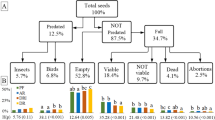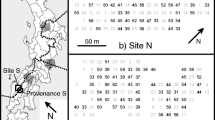Abstract
The success of direct seeding, as a low-cost approach to forest restoration, varies with tree species and seed characteristics. A system to predict which tree species are likely to be suitable for direct seeding would therefore be useful for improving forest restoration projects. Therefore, this study aimed to determine the effects of seed traits on the success of direct seeding to restore tropical forest in southern Thailand. Seeds of 19 indigenous lowland tropical forest tree species were collected, from both the east and west sides of the Thailand peninsular and the following parameters measured: seed size, shape, coat thickness and moisture content. Field trials were established to determine seed germination rates and to calculate a “direct seeding suitability score” for each species, which combined seedling establishment and growth rates. Seed size, shape and moisture content were associated with germination percentage. Species with higher seedling survival tended to have large or intermediate-sized seeds, round or oval seeds and seeds with low or medium moisture content. Only seed coat thickness was significantly correlated with the suitability score (r = 0.65, p < 0.01). Seed coat thickness >0.4 mm coincided with higher rank suitability score. These conditions successfully predicted the success or failure of direct seeding for 15 out of 19 species tested. Eight tree species are recommended as suitable for restoring lowland evergreen forest ecosystems in southern Thailand, by direct seeding.



Similar content being viewed by others
References
Aerts R, Maes W, November E, Negussie A, Hermy M, Muys B (2006) Restoring dry Afromontane forest using bird and nurse plant effects: direct sowing of Olea europaea ssp. cuspidata seeds. For Ecol Manag 230:23–31
Ashton MS, Gunatilleke CVS, Singhakumara BMP, Gunatilleke IAUN (2001) Restoration pathways for rain forest in southwest Sri Lanka: a review of concepts and models. For Ecol Manag 154:409–430
Badek B, Duijn Bv, Grzesik M (2006) Effects of water supply methods and seed moisture content on germination of China aster (Callistephus chinensis) and tomato (Lycopersicon esculentun Mill.) seeds. Eur J Agron 24:45–51
Balandier P, Frochot H, Sourisseau A (2009) Improvement of direct tree seeding with cover crops in afforestation: microclimate and resource availability induced by vegetation composition. For Ecol Manag 257:1716–1724
Bewley JD, Black M (1985) Physiology of development and germination in: seeds. Plenum Press, New York
Bonilla-Moheno M, Holl KD (2010) Direct seeding to restore tropical mature-forest species in areas of slash-and-burn agriculture. Restor Ecol 18:438–445
Campbell BD, Stafford DM, Ash AJ (1999) A rule-based model for the functional analysis of vegetation change in Australasian grasslands. J Veg Sci 10:723–730
Carmago JLC, Ferraz IDK, Imakawa AM (2002) Rehabilitation of degraded areas of central Amazonia using direct sowing of forest tree seeds. Restor Ecol 10:636–644
Cervantes V, Carabias J, Vazques-Yanes C (1996) Seed germination of woody legumes from deciduous tropical forest of southern Mexico. For Ecol Manag 82:171–184
Cole RJ, Holl KD, Keene CL, Zahawi RA (2011) Direct seeding of late-successional trees to restore tropical montane forest. For Ecol Manag 261:1590–1597
Coomes DA, Grubb PJ (2003) Colonization, tolerance, competition and seed-size variation within functional groups. Trends Ecol Evol 18:283–291
Crawley MJ (2007) The R book. Wiley, West Sussex
De Steven D (1991) Experiments on mechanisms of tree establishment in old-field succession: seedling emergence. Ecology 72:1066–1075
Doust SJ, Erskine PD, Lamb D (2006) Direct seeding to restore rainforest species: microsite effects on the early establishment and growth of rainforest tree seedlings on degraded land in the wet tropics of Australia. For Ecol Manag 234:333–343
Doust SJ, Erskine PD, Lamb D (2008) Restoring rainforest species by direct seeding: tree seedlings establishment and growth performance on degraded land in the wet tropics of Australia. For Ecol Manag 256:1178–1188
Edwards DGW (1980) Maturity and quality of tree seeds: a state-of-the-art review. Seed Sci Technol 28:625–657
Ellis RH, Hong TD, Roberts EH (1988) A low-moisture-content limit to logarithmic relations between seed moisture content and longevity. Ann Bot 61:405–408
Engel VL, Parrotta JA (2001) An evaluation of direct seeding for reforestation of degraded lands in central Sao Paulo state, Brazil. For Ecol Manag 152:169–181
Fenner M, Thompson K (2005) The ecology of seeds. Cambridge University Press, New York
FORRU (2006) Planting trees. In: Elliott S, Blakesley D, Maxwell JF, Doust S, Suwannaratana S (eds) How to plant a forest: the principles and practices of restoring tropical forests. Biology Department, Science Faculty, Chiang Mai University, Chiang Mai, pp 103–132
FORRU (2008) Propagating and identifying candidates framework. In: Elliott S, Blakesley D, Chairuangsri S (eds) Research for restoring tropical forest ecosystems: a practical guide. Biology Department, Chiang Mai, p 144
Garcia-Orth X, Martínez-Ramos M (2008) Seed dynamics of early and late successional tree species in tropical abandoned pasture: seed burial as a way of evading predation. Restor Ecol 16:435–443
Grime JP et al (1981) A comparative study of germination characteristics in a local flora. J Ecol 69:1017–1059
Grubb PJ, Metcalfe DJ (1996) Adaptation and inertia in the Australian tropical lowland rainforest flora: contradictory trends in intergeneric and intrageneric comparisons of seed size in relation to light demand. Funct Ecol 10:512–520
Hall JS, Ashton MS, Garen EJ, Jose S (2011) The ecology and ecosystem services of native trees: implications for reforestation and land restoration in Mesoamerica. For Ecol Manag 261:1553–1557
Hardwick K (1999) Tree colonization of abandoned agricultural clearings in seasonal tropical montane forest in nothern Thailand. Doctor of Philosophy. University of Wales, Bangor, p 168
Harris JA, Hobbs RJ, Higgs E, Aronson J (2006) Ecological restoration and global climate change. Restor Ecol 14:170–176
Hau CH (1997) Tree seed predation on degraded hillsides in Hong Kong. For Ecol Manag 99:215–221
Hooper E, Condit R, Legendre P (2002) Responses of 20 native tree species to reforestation strategies for abandoned farmland in Panama. Ecol Appl 12:1626–1641
ISTA (2006) International rules for seed testing, rules 2006. International Seed Testing Association, Zurich
Kleijn D (2003) Can establishment characteristics explain the poor colonization success of late successional grassland species on ex-arable land? Restor Ecol 11:131–138
Knowles OH, Parrotta JA (1995) Amazonian forest restoration: an innovative system for native species selection based on phenological data and field performance indices. Comm For Rev 74:230–243
Lamb D (2011) Ecological restoration. In: Lamb D (ed) Regreening the bare hills: tropical forest restoration in the Asia-Pacific region. Springer, New York, pp 325–355
Lamb D, Gilmour D (2003) Rehabilitation and restoration of degraded forests. IUCN, Gland, Switzerland and Cambridge, UK and WWF, Gland, Switzerland
Laurance WF et al (2011) Global warming, elevational ranges and the vulnerability of tropical biota. Biol Conserv 144:548–557
Leishman MR, Westoby M (1994) The role of large seed size in shaded conditions: experimental evidence. Funct Ecol 8:205–214
Liu Z, Yan Q, Li X, Ma J, Ling X (2007) Seed mass and shape, germination and plant abundance in a desertified grassland in northeastern Inner Mongolia, China. J Arid Environ 69:198–211
Manga VK, Sen DN (1995) Influence of seed traits on germination in Prosopis cineraria (L.) MacBride. J Arid Environ 31:371–375
Moles AT, Westoby M (2006) Seed size and plant strategy across the whole life cycle. Oikos 113:91–105
Moles AT, Hodson DW, Webb CJ (2000) Seed size and shape and persistence in the soil in the New Zealand flora. Okios 89:541–545
Moles AT, Ackerly DD, Webb CO, Tweddle JC, Dickie JB, Westoby M (2005) A brief history of seed size. Science 307:576–580
Muller-Landau HC (2010) The tolerance-fecundity trade-off and the maintenance of diversity in seed size. Proc Natl Acad Sci USA 107:4242–4247
Nepstad DC, Uhl C, Pereira CA, Cardosa da Silva JM (1996) A comparative study of tree establishment in abandoned pasture and mature forest of eastern Amazonia. Oikos 76:25–39
Parrotta JA, Knowles OH (1999) Restoration of tropical moist forests on bauxite-mined lands in the Brazilian Amazon. Restor Ecol 7:103–116
R Development Core Team (2010) R: a language and environment for statistical computing. R Foundation for Statistical Computing, Vienna, Austria
Sautu A, Baskin JM, Baskin CC, Condit R (2006) Studies on the seed biology of 100 native species of trees in a seasonal moist tropical forest, Panama, Central America. For Ecol Manag 234:245–263
Saverimuttu T, Westoby M (1996) Seedling longevity under deep shade in relation to seed size. J Ecol 84:681–689
Schmidt L (2007) Seed testing. In: Czeschlik D (ed) Tropical forest seeds. Springer, Heidelberg, p 409
Shah S, Tewari A, Tewari B, Singh RP (2010) Seed maturity indicators in Myrica esculenta, Buch-Ham. Ex. D.Don.: a multipurpose tree species of subtropical-temperate Himalayan region. New Forests 40:9–18
Shankar U (2006) Seed size as a predictor of germination success and early seedling growth in ‘hollong’ (Dipterocarpus macrocarpus Vesque). New Forests 31:305–320
Sun D, Dickinson GR, Bragg AL (1995) Direct seeding of Alphitonia petriei (Rhamnaceae) for gully revegetation in tropical northern Australia. For Ecol Manag 73:249–257
Tewari B, Tewari A, Shah S, Pande N, Singh RP (2011) Physical attributes as indicator of seed maturity and germination enhancement in Himalayan Wild Cherry (Prunus cerasoides D. Don.). New Forests 41:139–146
Thompson K, Band SR, Hodgson JG (1993) Seed size and shape predict persistent in soil. Funct Ecol 7:236–241
Tunjai P (2005) Appropriate tree species and techniques for direct seeding for forest restoration in Chiang Mai and Lamphun provinces. Master of Science. Chiang Mai University, Chiang Mai, p 107
Tunjai P (2011) Direct seeding for restoring tropical lowland forest ecosystems in southern Thailand. Doctor of Philosophy. Walailak University, Nakhon Si Thammarat, p 216
Turnbull LA, Rees M, Crawley MJ (1999) Seed mass and the competition/colonization trade-off: a sowing experiment. J Ecol 87:899–912
Van Ulft LH (2004) The effect of seed mass and gap size on seed fate of tropical rain forest tree species in Guyana. Plant Biol 6:214–221
Woods K, Elliott S (2004) Direct seeding for forest restoration on abandoned agricultural land in Northern Thailand. J Trop For Sci 16(2):248–259
Yu S, Sternberg M, Kutiel P, Chen H (2007) Seed mass, shape, and persistence in the soil seed bank of Israeli coastal sand dune flora. Evol Ecol Res 9:325–340
Acknowledgments
The authors thank Suwit Somechue and Theerasak Konghor for help with field works. We are grateful for institutional support provided by Walailak University, especially the Ecology and Biodiversity Program, School of Science and Chiang Mai University Herbarium and the Forest Restoration Research Unit (FORRU) at Biology Department, Faculty of Science. This work was financially supported by the TRF/BIOTEC Special Program for Biodiversity Research and Training grant BRT T-351014 and the Walailak University Fund. We also thank the Khlong Thom Nuea Sub-district Administration Organization and the Farm University, Walailak University for granting permission to establish experiments in their areas.
Author information
Authors and Affiliations
Corresponding author
Rights and permissions
About this article
Cite this article
Tunjai, P., Elliott, S. Effects of seed traits on the success of direct seeding for restoring southern Thailand’s lowland evergreen forest ecosystem. New Forests 43, 319–333 (2012). https://doi.org/10.1007/s11056-011-9283-7
Received:
Accepted:
Published:
Issue Date:
DOI: https://doi.org/10.1007/s11056-011-9283-7




